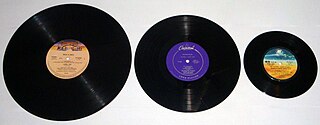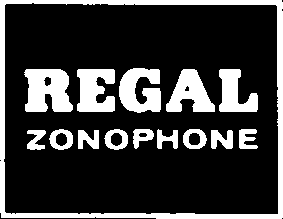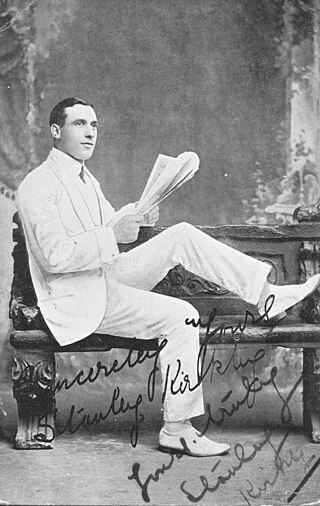
A phonograph, later called a gramophone, and since the 1940s a record player, or more recently a turntable, is a device for the mechanical and analogue reproduction of sound. The sound vibration waveforms are recorded as corresponding physical deviations of a helical or spiral groove engraved, etched, incised, or impressed into the surface of a rotating cylinder or disc, called a record. To recreate the sound, the surface is similarly rotated while a playback stylus traces the groove and is therefore vibrated by it, faintly reproducing the recorded sound. In early acoustic phonographs, the stylus vibrated a diaphragm that produced sound waves coupled to the open air through a flaring horn, or directly to the listener's ears through stethoscope-type earphones.

His Master's Voice is a painting and trademark by Francis Barraud that depicts a dog named Nipper listening to a wind-up disc gramophone whilst tilting his head, created in 1899.

A phonograph record or a vinyl record is an analog sound storage medium in the form of a flat disc with an inscribed, modulated spiral groove. The groove usually starts near the outside edge and ends near the center of the disc. The stored sound information is made audible by playing the record on a phonograph.

The Victor Talking Machine Company was an American recording company and phonograph manufacturer, incorporated in 1901. Victor was an independent enterprise until 1929 when it was purchased by the Radio Corporation of America (RCA) and became the RCA Victor Division of the Radio Corporation of America until late 1968, when it was renamed RCA Records.

Berliner Gramophone – its discs identified with an etched-in "E. Berliner's Gramophone" as the logo – was the first disc record label in the world. Its records were played on Emile Berliner's invention, the Gramophone, which competed with the wax cylinder–playing phonographs that were more common in the 1890s and could record.

Deutsche Grammophon is a German classical music record label that was the precursor of the corporation PolyGram. Headquartered in Berlin Friedrichshain, it is now part of Universal Music Group (UMG) since its merger with the UMG family of labels in 1999. Deutsche Grammophon is the world's oldest surviving established record company. Presidents of the company are Frank Briegmann, Chairman and CEO Central Europe of Universal Music Group and Clemens Trautmann.

The Gramophone Company Limited was a British phonograph manufacturer and record label, founded in April 1898 by Emil Berliner. It was one of the earliest record labels.

Regal Zonophone Records was a British record label formed in 1932, through a merger of the Regal and Zonophone labels. This followed the merger of those labels' respective parent companies – the Columbia Graphophone Company and the Gramophone Company – to form EMI. At the merger, those records from the Regal Records catalogue were prefixed 'MR' and those from the Zonophone Records catalogue were prefixed 'T'. Record releases after the merger continued using only the 'MR' prefix.

Frederick William Gaisberg was an American musician, recording engineer and one of the earliest classical music producers for the gramophone. He did not use the term 'producer', and was not an impresario like his protégé Walter Legge of EMI or an innovator like John Culshaw of Decca. Gaisberg concentrated on talent-scouting and persuading performers to make recordings for the newly invented Gramophone.

The overwhelming majority of records manufactured have been of certain sizes, playback speeds, and appearance. However, since the commercial adoption of the gramophone record, a wide variety of records have also been produced that do not fall into these categories, and they have served a variety of purposes.

Eldridge Reeves Johnson was an American businessman and engineer who founded the Victor Talking Machine Company in 1901 and built it into the leading American producer of phonographs and phonograph records and one of the leading phonograph companies in the world at the time. Victor was the corporate predecessor of RCA Records.

Regal Recordings is a British record label functioning as an imprint of Parlophone Records.

Ernest George Pike was an English tenor of the early 20th century who made numerous recordings in the first decades of the 20th century. After studying at the Guildhall School of Music in London, he worked as a bank clerk and sang as a church tenor before making his first recording "Take a Pair of Sparkling Eyes" for the Gramophone & Typewriter Company in 1904. He became the house tenor for HMV and made several hundred records in a career that spanned over twenty years.

Stanley Kirkby was an English baritone singer and variety artist of the early 20th century. He sang ballads and popular songs of the Edwardian era, the First World War and the inter-War period. He sang mostly in music halls and variety theatres and was a popular recording artist.

William F. Denny was an American vaudeville performer and pioneer recording artist.

Aretino was a United States record label, in business from about 1907 to 1914.
Gordon Parsons was an Australian country music singer-songwriter, best known as the composer of Slim Dusty's 1957 hit song "A Pub With No Beer". In 1982, Parsons was inducted into the Australian Roll of Renown.
Edison Bell was an English company that was the first distributor and an early manufacturer of gramophones and gramophone records. The company survived through several incarnations, becoming a top producer of budget records in England through the early 1930s until, after it was absorbed by Decca in 1932, production of various Edison Bell labels ceased.
The Discography of American Historical Recordings (DAHR) is a database catalog of master recordings made by American record companies during the 78rpm era. The 78rpm era was the time period in which any flat disc records were being played at a speed of 78 revolutions per minute. The DAHR provides some of these original recordings, free of charge, via audio streaming, along with access to the production catalogs of those same companies. DAHR is part of the American Discography Project (ADP), and is funded and operated in partnership by the University of California, Santa Barbara, the National Endowment for the Humanities, and the Packard Humanities Institute.
















